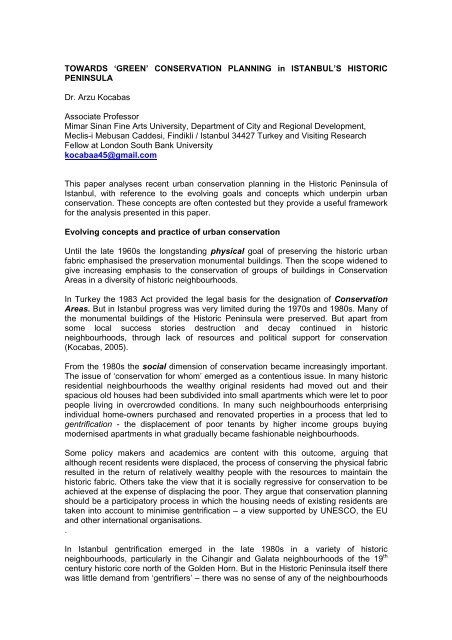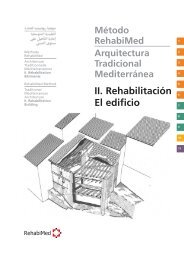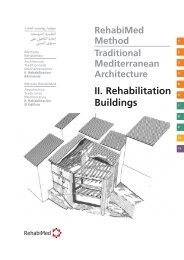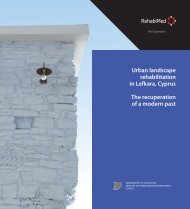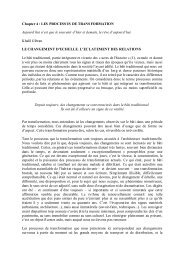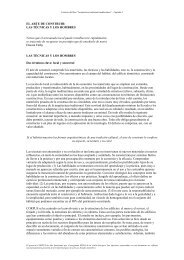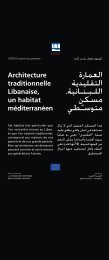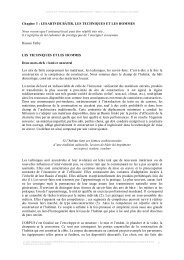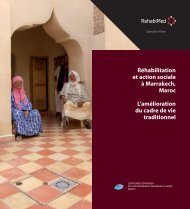CONSERVATION PLANNING in ISTANBUL'S ... - RehabiMed
CONSERVATION PLANNING in ISTANBUL'S ... - RehabiMed
CONSERVATION PLANNING in ISTANBUL'S ... - RehabiMed
You also want an ePaper? Increase the reach of your titles
YUMPU automatically turns print PDFs into web optimized ePapers that Google loves.
TOWARDS ‘GREEN’ <strong>CONSERVATION</strong> <strong>PLANNING</strong> <strong>in</strong> ISTANBUL’S HISTORIC<br />
PENINSULA<br />
Dr. Arzu Kocabas<br />
Associate Professor<br />
Mimar S<strong>in</strong>an F<strong>in</strong>e Arts University, Department of City and Regional Development,<br />
Meclis-i Mebusan Caddesi, F<strong>in</strong>dikli / Istanbul 34427 Turkey and Visit<strong>in</strong>g Research<br />
Fellow at London South Bank University<br />
kocabaa45@gmail.com<br />
This paper analyses recent urban conservation plann<strong>in</strong>g <strong>in</strong> the Historic Pen<strong>in</strong>sula of<br />
Istanbul, with reference to the evolv<strong>in</strong>g goals and concepts which underp<strong>in</strong> urban<br />
conservation. These concepts are often contested but they provide a useful framework<br />
for the analysis presented <strong>in</strong> this paper.<br />
Evolv<strong>in</strong>g concepts and practice of urban conservation<br />
Until the late 1960s the longstand<strong>in</strong>g physical goal of preserv<strong>in</strong>g the historic urban<br />
fabric emphasised the preservation monumental build<strong>in</strong>gs. Then the scope widened to<br />
give <strong>in</strong>creas<strong>in</strong>g emphasis to the conservation of groups of build<strong>in</strong>gs <strong>in</strong> Conservation<br />
Areas <strong>in</strong> a diversity of historic neighbourhoods.<br />
In Turkey the 1983 Act provided the legal basis for the designation of Conservation<br />
Areas. But <strong>in</strong> Istanbul progress was very limited dur<strong>in</strong>g the 1970s and 1980s. Many of<br />
the monumental build<strong>in</strong>gs of the Historic Pen<strong>in</strong>sula were preserved. But apart from<br />
some local success stories destruction and decay cont<strong>in</strong>ued <strong>in</strong> historic<br />
neighbourhoods, through lack of resources and political support for conservation<br />
(Kocabas, 2005).<br />
From the 1980s the social dimension of conservation became <strong>in</strong>creas<strong>in</strong>gly important.<br />
The issue of ‘conservation for whom’ emerged as a contentious issue. In many historic<br />
residential neighbourhoods the wealthy orig<strong>in</strong>al residents had moved out and their<br />
spacious old houses had been subdivided <strong>in</strong>to small apartments which were let to poor<br />
people liv<strong>in</strong>g <strong>in</strong> overcrowded conditions. In many such neighbourhoods enterpris<strong>in</strong>g<br />
<strong>in</strong>dividual home-owners purchased and renovated properties <strong>in</strong> a process that led to<br />
gentrification - the displacement of poor tenants by higher <strong>in</strong>come groups buy<strong>in</strong>g<br />
modernised apartments <strong>in</strong> what gradually became fashionable neighbourhoods.<br />
Some policy makers and academics are content with this outcome, argu<strong>in</strong>g that<br />
although recent residents were displaced, the process of conserv<strong>in</strong>g the physical fabric<br />
resulted <strong>in</strong> the return of relatively wealthy people with the resources to ma<strong>in</strong>ta<strong>in</strong> the<br />
historic fabric. Others take the view that it is socially regressive for conservation to be<br />
achieved at the expense of displac<strong>in</strong>g the poor. They argue that conservation plann<strong>in</strong>g<br />
should be a participatory process <strong>in</strong> which the hous<strong>in</strong>g needs of exist<strong>in</strong>g residents are<br />
taken <strong>in</strong>to account to m<strong>in</strong>imise gentrification – a view supported by UNESCO, the EU<br />
and other <strong>in</strong>ternational organisations.<br />
.<br />
In Istanbul gentrification emerged <strong>in</strong> the late 1980s <strong>in</strong> a variety of historic<br />
neighbourhoods, particularly <strong>in</strong> the Cihangir and Galata neighbourhoods of the 19 th<br />
century historic core north of the Golden Horn. But <strong>in</strong> the Historic Pen<strong>in</strong>sula itself there<br />
was little demand from ‘gentrifiers’ – there was no sense of any of the neighbourhoods
<strong>in</strong> the area mov<strong>in</strong>g up-market. However, many build<strong>in</strong>gs were lost to demolition (often<br />
to provide <strong>in</strong>formal park<strong>in</strong>g lots) when it was not possible to f<strong>in</strong>d economically viable<br />
uses for them.<br />
In many countries a parallel and <strong>in</strong>terlock<strong>in</strong>g development of conservation plann<strong>in</strong>g<br />
was the <strong>in</strong>creas<strong>in</strong>g attention given to the economic dimension – the issue of new uses<br />
for old build<strong>in</strong>gs. In this context conservation became <strong>in</strong>extricably l<strong>in</strong>ked with tourism<br />
and the creation of jobs, particularly <strong>in</strong> central neighbourhoods where old build<strong>in</strong>gs<br />
could be converted to shops (often boutiques) and small hotels. This process could<br />
also lead to displacement of the poor. However, it could be argued that this was at<br />
least partially offset by the creation of jobs which benefited local people and it was<br />
argued that there would be more political support for conservation when what was<br />
historically had been seen as an elite pre-occupation could be l<strong>in</strong>ked to urban<br />
economic development and job creation for lower <strong>in</strong>come groups. Nonetheless, there<br />
are many circumstances <strong>in</strong> which economic development <strong>in</strong>terests have been allowed<br />
too much <strong>in</strong>fluence and tourism has comb<strong>in</strong>ed with gentrification to all but destroy the<br />
historic built environment, <strong>in</strong> both physical and social terms.<br />
In Turkey the Tourism Promotion Act (1982) provided the legal basis for state support<br />
for the development of tourist facilities. But this enabled legal redevelopment projects<br />
to take place <strong>in</strong> the historic city, such as skyscraper blocks, which were the antithesis<br />
of the outcomes be<strong>in</strong>g sought by conservation plann<strong>in</strong>g (Ek<strong>in</strong>ci, 1993, 2003). In the<br />
follow<strong>in</strong>g year Turkey signed the Convention on the Protection of World Cultural and<br />
Natural Heritage and embodied its provisions <strong>in</strong> the 1983 Conservation Act, thus<br />
<strong>in</strong>troduc<strong>in</strong>g an <strong>in</strong>ternational dimension to conservation debates <strong>in</strong> Istanbul. This<br />
legislation also gave metropolitan municipalities the responsibility for produc<strong>in</strong>g<br />
statutory and legally b<strong>in</strong>d<strong>in</strong>g Conservation Oriented Development Plans (CODP). In<br />
1985, the UNESCO World Heritage Centre <strong>in</strong>cluded four zones of the Historic<br />
Pen<strong>in</strong>sula on the World Heritage List. But was not until 1995 that these areas were<br />
designated Conservation Areas and not until 2003 that a CODP for the Historic<br />
Pen<strong>in</strong>sula was f<strong>in</strong>ally approved. The weak conservation activity dur<strong>in</strong>g the 1980s and<br />
1990s has been shown to be significantly due to the development orientation of the<br />
Mayors of Istanbul (Kocabas, 2000 and 2006).<br />
The long awaited CODP argued for the long-term decentralisation of many nonresidential<br />
uses – offices, factories, hospitals. This would enable the rehabilitation of a<br />
m<strong>in</strong>ority of the rema<strong>in</strong><strong>in</strong>g traditional build<strong>in</strong>gs to be accompanied by substantial<br />
hous<strong>in</strong>g-led redevelopment. The dom<strong>in</strong>ant redevelopment component would deliver<br />
replica traditional dwell<strong>in</strong>gs at medium densities, attract higher and middle <strong>in</strong>come<br />
families to the area, achieve the earthquake resistant standards which are so<br />
necessary <strong>in</strong> the earthquake vulnerable Historic Pen<strong>in</strong>sula and by re-produc<strong>in</strong>g the<br />
exist<strong>in</strong>g build<strong>in</strong>g l<strong>in</strong>es would provide an appropriate sett<strong>in</strong>g for many historic<br />
monuments <strong>in</strong> the area.<br />
This approach was controversial from the outset, not least because it was <strong>in</strong> conflict<br />
with the emergence <strong>in</strong> Istanbul of the concept of ‘<strong>in</strong>tegrated urban conservation’.<br />
This approach emphasises the need for conservation plann<strong>in</strong>g to systematically l<strong>in</strong>k the<br />
physical, social and economic dimensions of conservation<br />
and their complex and often contradictory <strong>in</strong>terrelationships. This approach was applied<br />
<strong>in</strong> Istanbul by a major UNESCO funded study – the Istanbul Historic Pen<strong>in</strong>sula<br />
Conservation Study (Gulersoy, et. al., 2004) which established the pr<strong>in</strong>ciples of this<br />
approach for the Historic Pen<strong>in</strong>sula and prepared advisory Conservation Area Plans for<br />
key neighbourhoods. In contrast to the CODP, this approach argued that the protection<br />
of the rema<strong>in</strong><strong>in</strong>g authentic historic environment – the historic build<strong>in</strong>gs <strong>in</strong> their current<br />
sett<strong>in</strong>g – should be the first priority. Thus the overall aim should be to emphasise
ehabilitation, rather than the decentralisation of jobs and major residential<br />
redevelopment, and the improvement of the hous<strong>in</strong>g conditions of exist<strong>in</strong>g residents,<br />
rather than a programme of planned gentrification.<br />
Not surpris<strong>in</strong>gly, the work to implement the CODP <strong>in</strong> recent years has been mired <strong>in</strong><br />
controversy. Initially, the lead<strong>in</strong>g edge of this work was the Museum City Project which<br />
was the responsibility of the Greater Istanbul Metropolitan Municipality (GIMM).This<br />
project used historical maps and plans, and street by street surveys to establish a<br />
digital record of the orig<strong>in</strong>al build<strong>in</strong>gs and layout of the Ottoman Historic Pen<strong>in</strong>sula. But<br />
before the action plans to re-create this environment got to implementation stage, the<br />
project was closed down.<br />
By default it is the Renewal Areas be<strong>in</strong>g prepared and implemented by the Mayor of<br />
Fatih which are tak<strong>in</strong>g forward the ‘conservation’ of key neighbourhoods <strong>in</strong> the Historic<br />
Pen<strong>in</strong>sula. These were based on the use of a new law 5366 which gave District Mayors<br />
the powers and resources to implement Renewal Area Plans. However, the powers of<br />
compulsory purchase have been used to ensure the demolition of Sulukule, the oldest<br />
Romany settlement <strong>in</strong> Europe. This planned gentrification has re-located the Romany<br />
community to an estate some 40km away, where the rents are unaffordable and the<br />
community has dis<strong>in</strong>tegrated. The fate of the residents of Sulukule has become a focal<br />
po<strong>in</strong>t for protest aga<strong>in</strong>st further Renewal Area plans elsewhere <strong>in</strong> the Historic<br />
Pen<strong>in</strong>sula.<br />
All this has been happen<strong>in</strong>g <strong>in</strong> the context of the pressure be<strong>in</strong>g placed on the Turkish<br />
authorities to prepare and implement an Area Management Plan for the Historic<br />
Pen<strong>in</strong>sula World Heritage Sites. The UNESCO threat <strong>in</strong> 2003 to place the Historical<br />
Pen<strong>in</strong>sula on the list of World Cultural Heritage <strong>in</strong> Danger has focused the m<strong>in</strong>ds of<br />
decision makers. Successive two year monitor<strong>in</strong>g visits have prompted action. But the<br />
progress towards <strong>in</strong>tegrated conservation rema<strong>in</strong>s <strong>in</strong>hibited by the unresolved<br />
rehabilitation versus redevelopment debate and the fragmentation of plann<strong>in</strong>g for the<br />
Historic Pen<strong>in</strong>sula. However, as a result of a long drawn out set of court proceed<strong>in</strong>gs,<br />
not untypical of the operation of the Turkish plann<strong>in</strong>g system, the CODP for the Historic<br />
Pen<strong>in</strong>sula was annulled <strong>in</strong> November 2009. Thus <strong>in</strong> early 2010 there is no legally<br />
b<strong>in</strong>d<strong>in</strong>g framework for urban conservation plann<strong>in</strong>g <strong>in</strong> the Historic Pen<strong>in</strong>sula.<br />
From <strong>in</strong>tegrated conservation to susta<strong>in</strong>able, low carbon conservation?<br />
The struggle to develop and implement an Istanbul version of <strong>in</strong>tegrated conservation<br />
cont<strong>in</strong>ues aga<strong>in</strong>st the backcloth of Istanbul be<strong>in</strong>g European City of Culture 2010. The<br />
preparations for the year have been controversial, not least <strong>in</strong> terms of how the central<br />
government, local government and NGOs should work together. But whatever the<br />
outcome, the ECOC 2010 process is giv<strong>in</strong>g a higher profile to the issue of urban<br />
conservation <strong>in</strong> Istanbul.<br />
In this context it seems appropriate to suggest a new impetus for urban conservation<br />
plann<strong>in</strong>g – the need to l<strong>in</strong>k the cont<strong>in</strong>u<strong>in</strong>g development of the <strong>in</strong>tegrated approach to<br />
the urban dimensions of the climate change agenda, by develop<strong>in</strong>g the concept and<br />
practice of susta<strong>in</strong>able, low carbon conservation.<br />
In the aftermath of the Rio Earth Summit <strong>in</strong> 1992, the concept of susta<strong>in</strong>able<br />
development began to shape the urban agenda and with<strong>in</strong> not much more than a<br />
decade there was a consensus <strong>in</strong> developed countries on the need for plann<strong>in</strong>g to<br />
support the development of susta<strong>in</strong>able cities and towns. This means <strong>in</strong>volv<strong>in</strong>g the<br />
three <strong>in</strong>terrelated dimensions of provid<strong>in</strong>g:
• the physical <strong>in</strong>frastructure (offices, transport, hous<strong>in</strong>g, social and community<br />
facilities) necessary for susta<strong>in</strong>able urban economic development which creates<br />
wealth and jobs;<br />
• promot<strong>in</strong>g <strong>in</strong>creased social equality and a fairer society by ensur<strong>in</strong>g that all social<br />
groups share <strong>in</strong> this prosperity; and<br />
• m<strong>in</strong>imis<strong>in</strong>g the adverse environmental impact of cities, by reduc<strong>in</strong>g pollution and<br />
waste.<br />
In this context urban conservation was promoted as a key component of plann<strong>in</strong>g for<br />
susta<strong>in</strong>able urban development because of its role of safeguard<strong>in</strong>g the historic fabric<br />
for future generations. The <strong>in</strong>ter-generational ethos of urban conservation chimed well<br />
with this redef<strong>in</strong>ition of the role of city and regional plann<strong>in</strong>g. However, whilst the<br />
rationale for urban conservation plann<strong>in</strong>g has been strengthened <strong>in</strong> this way, its<br />
content and methods are only now explicitly embrac<strong>in</strong>g the urban dimension of the<br />
climate change agenda, which focuses on the need to move to reduc<strong>in</strong>g CO2<br />
emissions from cities and towns. Thus <strong>in</strong> the UK central government is emphasis<strong>in</strong>g<br />
the importance of this issue (EH, 2007). The London Borough of Har<strong>in</strong>gey is one of<br />
several local authorities <strong>in</strong> England that has developed guidel<strong>in</strong>es for the <strong>in</strong>tegration of<br />
micro-renewables technology, such as solar panels, <strong>in</strong> conservation schemes (2009).<br />
What would be <strong>in</strong>volved <strong>in</strong> retrofitt<strong>in</strong>g the Historic Pen<strong>in</strong>sula? In practical terms, at the<br />
level of <strong>in</strong>dividual build<strong>in</strong>gs it would <strong>in</strong>clude:<br />
• measures to achieve high levels of <strong>in</strong>sulation to be <strong>in</strong>cluded rehabilitation<br />
specifications, and high standards of energy efficient design (such as ‘passivhaus’)<br />
to be achieved for any replacement build<strong>in</strong>gs <strong>in</strong> conservation areas; and<br />
• measures to supply energy from renewable sources, from micro-generation<br />
<strong>in</strong>stalled <strong>in</strong>/on build<strong>in</strong>gs (e.g. solar panels, ground source heat pumps) or at the<br />
conservation area/neighbourhood level – eg. comb<strong>in</strong>ed heat and power and the<br />
use of bio-mass fuels.<br />
At the neighbourhood level this could <strong>in</strong>clude ensur<strong>in</strong>g lower carbon emissions from<br />
all public build<strong>in</strong>gs e.g. schools, hospitals and mosques, restrictions on car usage,<br />
plant<strong>in</strong>g trees to absorb CO2, susta<strong>in</strong><strong>in</strong>g traditional fresh food supplies through street<br />
markets, reduc<strong>in</strong>g per capita water consumption and improv<strong>in</strong>g waste management.<br />
There are some straws <strong>in</strong> the w<strong>in</strong>d. Turkey has signed the Kyoto Treaty and <strong>in</strong> the not<br />
too distant future will adopt national carbon reduction targets which will require major<br />
reductions <strong>in</strong> emissions from the hous<strong>in</strong>g stock, <strong>in</strong>clud<strong>in</strong>g historic hous<strong>in</strong>g. In Istanbul<br />
the GIMM is work<strong>in</strong>g with an <strong>in</strong>ternational NGO EMBARQ on a Historic Pen<strong>in</strong>sula Low<br />
Emissions project to reduce air pollution caused by cars.<br />
The need is for feasibility study/demonstration project(s) which would identify the<br />
policies, methods and techniques to ensure that conservation not only preserves the<br />
historic built environment and meets economic and social objectives, but also meets<br />
environmental objectives by reduc<strong>in</strong>g the carbon emissions from historic build<strong>in</strong>gs and<br />
neighbourhoods. This additional ‘climate change dimension’ is essential if genu<strong>in</strong>e<br />
‘susta<strong>in</strong>able conservation’ is to be achieved. The launch of such a feasibility study<br />
would be a highly appropriate contribution to ECOC 2010.<br />
Note<br />
This paper has drawn on an ongo<strong>in</strong>g <strong>in</strong>ternational comparative study of conservation <strong>in</strong><br />
Istanbul and London, currently be<strong>in</strong>g undertaken with Dr. Bob Jarvis and Professor<br />
Mike Gibson of London South Bank University (LSBU).
References<br />
EH (2007) Climate change and the historic environment, London.<br />
Ek<strong>in</strong>ci, O. (1993) ‘The law of the promotion of tourism: the plunder<strong>in</strong>g of Istanbul,<br />
İstanbul’93 selections, Istanbul: Tarih Vakfı.<br />
Ek<strong>in</strong>ci, O. (2003) ‘Istanbul’un sur ici sınavı’, Cumhuriyet, 21.8.2003.<br />
Gulersoy, N. Z. et. al. (2004) Istanbul project: Istanbul Historic Pen<strong>in</strong>sula conservation<br />
study, UNESCO WH Project, Istanbul: ITU, Urban and Environmental Plann<strong>in</strong>g and<br />
Research Centre.<br />
Kocabas, A. (2000) Urban conservation plann<strong>in</strong>g and development outcomes <strong>in</strong><br />
conservation areas <strong>in</strong> central Istanbul and central London: 1969-1989, <strong>in</strong> pr<strong>in</strong>t PhD<br />
thesis, London: London South Bank University.<br />
Kocabas, A. (2006) ‘Urban Conservation <strong>in</strong> Istanbul: Evaluation and Reconceptualization’,<br />
Habitat International, A Journal of the Study of Human Settlements,<br />
Elsevier.<br />
LBH (2009) Use of Renewable Energy Systems: Historic Build<strong>in</strong>gs and Conservation<br />
Areas, London.


